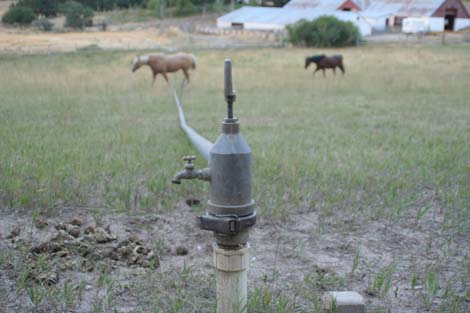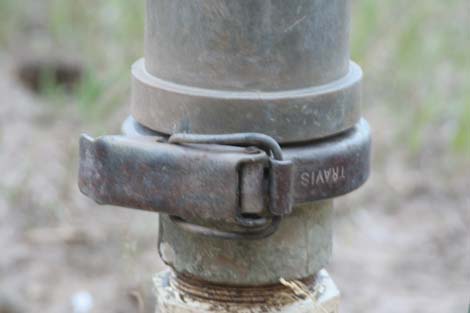 Last summer my husband took a youth group to Lake Powell. That left the children and me to move the sprinkler pipe. Up until that time, I had helped move the pipe but had never been responsible for shutting off a riser (the white part of the pipe in the picture) and moving the riser opener (the milk jug looking thing clamped on top of the white pipe) to a new riser. I had no trouble removing the riser opener or attaching it to the new riser. In fact, it clamped down so easily I wondered why my husband had been so careful to point out that the opener had to cover the lip all the way around the pipe. It seemed obvious to me–I couldn’t imagine how you could possibly close the latch without everything lined up just so.
Last summer my husband took a youth group to Lake Powell. That left the children and me to move the sprinkler pipe. Up until that time, I had helped move the pipe but had never been responsible for shutting off a riser (the white part of the pipe in the picture) and moving the riser opener (the milk jug looking thing clamped on top of the white pipe) to a new riser. I had no trouble removing the riser opener or attaching it to the new riser. In fact, it clamped down so easily I wondered why my husband had been so careful to point out that the opener had to cover the lip all the way around the pipe. It seemed obvious to me–I couldn’t imagine how you could possibly close the latch without everything lined up just so.
Then I turned the handle on top of the riser opener a half turn to start pressurizing the system. Water began spraying out under the lip. It probably needed more pressure to seal up. I gave it another turn. My children jumped back. The water soaked a wagon wheel sized area around the riser and poured into my knee-high rubber irrigation boots. I cranked it open some more. My hair flew up as water shot up past my head in a steady stream. Blinking water out of my eyes, I cranked in the opposite direction but the stream never slowed.
My heart started pounding. I must have blown a riser. I’d seen a blown riser from the roadside. It looked like Old Faithful which meant there was a lot more water waiting to blow off the riser opener. I struggled to turn the water off again–not wanting to believe I’d blown a riser. Didn’t tractors do things like that? Not a city girl out moving a riser opener.
No amount of turning disturbed the seven foot fountain. I had no alternative but to knock on my in-laws’ door and explain that I had blown a riser. My feet made sucking noises in my boots as I sloshed my way out of the field. Water pooled on my in-laws’ porch where I waited for someone to answer the door. It opened. I took a deep breath. “I think I blew a riser.”
My father in-law stared back at me in disbelief. “Where?”
“The oat field. I guess we’ll have to turn everything off. I’ll do it if you can tell me where the turn off is.” I was grateful for his calm demeanor but wished I could melt into the puddle of water collecting beneath me.
He stepped onto the porch in his stocking feet. “Let’s just go take a look.” He was recovering from extensive back surgery and thus on furlough from farm work. The last thing I wanted was for him to have to go tromping through the field. Some help I was breaking a riser.
I waited while he pulled on some irrigation boots. Then we hopped on his four-wheeler and sped into the field. “You didn’t blow a riser,” he explained after turning the motor off.
Relief washed through me. “So what do I do? It won’t turn off.”
He tilted his head to see through the spray. Instead of sitting upright atop the riser, the riser open balanced at a precarious angle. It looked like a mouth spewing copious amounts of water into the oat field. “It’ll turn off.” He searched the four-wheeler’s saddle bags for a wrench. “First get the riser opener off. You gotta make sure you get that lip in.”
I walked back into the fountain’s shower. My feet sunk into the soft mud. With each step the mud threatened to swalllow my boot. I took a deep breath, held it and plunged forward. The force of the spray pelted forcefully against me. My ice-cold fingers fumbled against the latch. I stood up and to my horror saw my father in-law, wrench in hand, slowly making his way through the quagmire. Fighting to retain boots and balance with every step knee-deep in mud was surely not part of his physical therapy. “I’ll get it! Just tell me what to do.” I yelled above the roaring water.
“Here let me.”
We continued like that, me asking what to do, him not sure I could understand, me worried he would fall or worse yet twist and fall undoing every bit of good the surgery had done. At some point my mother in-law arrived. She’d been moving sprinkler pipe in the horse pasture (pictured above). I don’t remember who finally got the water off, but I do remember my mother in-law pointing to the riser opener and asking me about the lip my husband had so carefully pointed out to me before he left. “Did you get the lip in all the way around?”
“Yeah.” I nodded. “It won’t close unless you do.”
“Not always.”
I still couldn’t see how that was possible. She reattached the riser opener and turned the water on. Everything worked fine–until I had to move risers again. The same thing happened. Only this time I knew I hadn’t blown a riser. I got the water off myself, then got my mother in-law to come help me. Again, with her there everything worked just as it should. She showed me that lip thing again, though.
The third time I had to move the riser opener something happened. This riser stood higher out of the ground than the other two had. For the first time I saw a lip on the riser where it widened towards the top. So this was the lip everyone kept talking about. It wasn’t the little ridge on the opener but a lip on the riser itself. It was an AHA! moment of epic proportions. I securely clamped everything together, opened the riser, and got the water going ALL BY MYSELF that day.
As I’ve been revising my book, I’ve been reminded of this experience several times. I’ve carefully studied books on how to write, I’ve read and dissected favorite books, and I’ve tried to implement my findings into my manuscript. Or so I thought. I’m astounded at the mistakes I’ve made. And not just one or two–I’m talking entire concepts I thought I grasped.
One example being motivation and reaction sequences. I nearly cried when I realized I’d gotten it wrong…repeatedly. Then I sat down and went through my entire document correcting my mistakes. (I hesitate to say it’s right even now given my experience with the riser opener.) However, at least I recognized my error. That’s progress, and as long as I can see my mistakes, I can fix them. So as I go through my manuscript yet again, I’ll be searching for the lip on the riser.





Whew! Fixing sprinklers? I applaud you. I would have dragged out the hose and watered by hand even if it took me all week rather than try anything like that!
What an interesting parallel. How is the manuscript coming? I admire so much the plunge you’re taking that way, and the breadth of your study. I’m not sure what motivation and reaction sequence even means. 🙂
P.S. I’ll look for that soup recipe today to send to you!
I thought I was halfway through my final revision until I started reading a new novel yesterday. The author’s imagery on page one alone made me wonder if I’ll ever be ready. (Kind of like reading your blog. You have such a beautiful way of putting words together.) Sigh. Part of me just wants to send it in and get it over with. The other part worries that I’ll be setting myself up for rejection if I don’t work on it some more.
So maybe I’ll make your soup and worry about it later.
I was LOL. totally fascinating and hilarious post.
I’ll show my complete ignorance in admitting I have no idea what you’re talking about as far as sequences and actions reactions or whatever.
But on a good note, you won the Lemonade Award. Check out my blog for the details!
thank you for your kind words! Hey, here’s the soup. I figure with all of the teasing and foreshadowing, I may as well put it here instead of a personal email, right? Sorry it took me a while to find it again. i’ve been sick and losing brain cells faster than I normally do.
Zuppa toscana
Serves about 10
1 pound Italian ground sausage
3 quarts good quality chicken broth (homemade is best)
1/2 cup heavy cream
8-10 medium potatoes — scrubbed, quartered and cut into 1/4-inch slices (no need to peel!)
4 cups chopped kale
1/2 tsp. salt
1/2 tsp. crushed red pepper flakes
Bacon, cooked crisp for garnish (optional)
Brown sausage and drain well.
Combine broth and cream over medium heat. Add vegetables, sausage, salt and crushed red pepper flakes. Simmer over medium heat until potatoes are tender, about 20 minutes. Stir occasionally. Add bacon pieces just before serving.
I often make it in a slow cooker with these adaptations: Combine browned sausage, broth, potatoes and seasonings. Cook on high power for about five hours. Add kale for last half hour of cooking. Stir in cream just before serving.
Spinach may be substituted for kale.
This is a very versatile recipe. Keeping the broth and cream ratio the same, you can play with the quantities of the other ingredients all you want.
P.S. I’d love to spend more time on your lemonade award blogs. Will you have their addresses again?